This article needs additional citations for verification .(February 2018) |
Pursuit racing is where two or more competitors (or teams) are either chasing after each other or chasing after a lead competitor or team.
This article needs additional citations for verification .(February 2018) |
Pursuit racing is where two or more competitors (or teams) are either chasing after each other or chasing after a lead competitor or team.
In cycling, pursuit racing is a form of track racing.
In individual pursuit, two cyclists begin on opposite sides of the velodrome. After starting at the same time, each cyclist attempts to catch up to the other for the win. The cyclists are also timed, for comparison with other competitors. Men race for 4 kilometres (2.5 mi); women race for 3 kilometres (1.9 mi). At the Olympics beginning in 2012, individual pursuit is competed only as part of the omnium event. [1]
Team pursuit works similarly to individual pursuit. Two teams – each with three or four cyclists – start from opposite sides of the track. The team earns their time based on the third-finishing rider. All events are 4 kilometres (2.5 mi), although through the 2011–2012 season the women's competitions were three cyclists over 3 kilometres (1.9 mi). [2] [3]
The modern pentathlon is formatted such that the final event, a cross-country run with target shooting, is essentially a pursuit race. Athlete performance in the prior events determines the times in which they start the race. [4] The idea is that the first athlete to cross the finish line wins the entire event. [5]
In biathlon, pursuit is the second part of a sprint-pursuit race. The sprint is held first. [6] In the subsequent pursuit section, the competitors' starts are staggered according to their times: [6] [7] the sprint winner starts first, whoever finished second by a certain time follows the leader by that time, and so on. (For example, Competitor F finished 5 seconds ahead of Competitor S in the Sprint, so Competitor F will start 5 seconds ahead of Competitor S in the Pursuit event.) Pursuit can follow up to the individual race too. They just divide by 2 your extra time behind the winner of individual race.
In cross-country skiing a pursuit is a race where the skiers start according to results in one or more previous races. The final stage of a ski tour event (i.e. Nordic Opening, Tour de Ski and World Cup Finals) is usually a pursuit where the overall leader starts first and is followed by the others starting behind according to their cumulative time from the stages raced before the pursuit.
In Nordic combined, the pursuit is determined by how well the competitors or team do in the ski jumping part of the competition. This is part of the Gundersen method developed in the 1980s. For the 15 km individual and 7.5 km sprint competitions, the computation is a 1-point advantage at the ski jump equals a 4-second advantage at the start of the cross-country skiing part of the competition. (For example, Competitor A finished the ski jump with 5 more points than Competitor B, so Competitor B must start 20 seconds after Competitor A in the cross-country skiing part.) For the 4 x 5 km team event prior to 2005, the computation was a 1-point advantage at the ski jump equals a 1.5 second advantage in the cross-country skiing part of the competition; since 2005, that computation is 1 point equals 1 second.
Long-track speed skating also has pursuit races. In team pursuit, two teams – each team comprising three skaters – begin on opposite sides of the ice, start at the same time, and attempt to catch the other team in the shortest elapsed time as measured by the third skater. [8] Men race for eight laps and women for six laps. [8]

The biathlon is a winter sport that combines cross-country skiing and rifle shooting. It is treated as a race, with contestants skiing through a cross-country trail whose distance is divided into shooting rounds. The shooting rounds are not timed per se, but depending on the competition, missed shots result in extra distance or time being added to the contestant's total.

Nordic combined is a winter sport in which athletes compete in cross-country skiing and ski jumping. The Nordic combined at the Winter Olympics has been held since the first Winter Olympics in 1924, while the FIS Nordic Combined World Cup has been held since 1983. Many Nordic combined competitions use the Gundersen method, where placement in the ski jumping segment results in time (dis)advantages added to the contestant's total in the cross-country skiing segment.

Ole Einar Bjørndalen is a retired Norwegian professional biathlete and coach, often referred to by the nickname, the "King of Biathlon". With 13 Winter Olympic Games medals, he is second on the list of multiple medalists behind Marit Bjørgen who has won 15 medals. He is also the most successful biathlete of all time at the Biathlon World Championships, having won 45 medals. With 95 World Cup wins, Bjørndalen is ranked first all-time for career victories on the Biathlon World Cup tour. He has won the Overall World Cup title six times, in 1997–98, in 2002–03, in 2004–05, in 2005–06, in 2007–08 and in 2008–09.
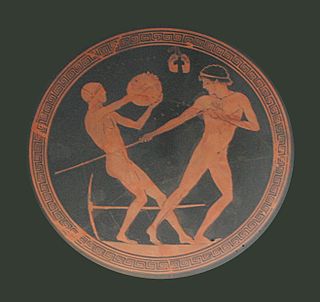
A pentathlon is a contest featuring five events. The name is derived from Greek: combining the words pente (five) and -athlon (competition). The first pentathlon was documented in Ancient Greece and was part of the Ancient Olympic Games. Five events were contested over one day for the Ancient Olympic pentathlon, starting with the long jump, javelin throwing, and discus throwing, followed by the stadion and wrestling. Pentathletes were considered to be among the most skilled athletes, and their training was often part of military service—each of the five events in the pentathlon was thought to be useful in war or battle.

Frode Andresen is a former Norwegian biathlete and cross-country skier.
This article contains a chronological summary of the 2006 Winter Olympics in Turin, Italy.
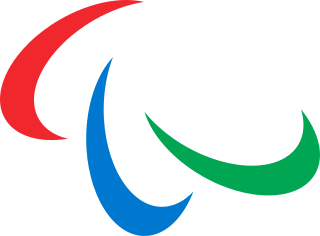
Paralympic cross-country skiing is an adaptation of cross-country skiing for athletes with disabilities. Paralympic cross-country skiing is one of two Nordic skiing disciplines in the Winter Paralympic Games; the other is biathlon. Competition is governed by the International Paralympic Committee (IPC).
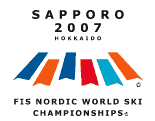
The FIS Nordic World Ski Championships 2007 took place 22 February – 4 March 2007 in Sapporo, Japan. It was the second time this city has hosted these championships, having previously done so in the 1972 Winter Olympics. Sapporo was selected as venue by vote at the 43rd FIS World Congress in Portorož, Slovenia, on 6 June 2002. It also marked the third time the championships were hosted outside Europe in a year that did not coincide with the Winter Olympics; it was the first championship held in Asia. The ski jumping team normal hill event was not held, as it had been in 2005.
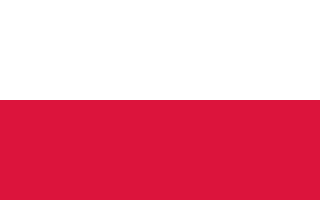
Poland first participated at the Olympic Games in 1924, and has sent athletes to compete in every Summer Olympic Games since then, except for the 1984 Games, when they were forced to be part of the Soviet-led boycott of the 1984 Summer Olympics. Poland has also participated in every Winter Olympic Games.

Miriam Neureuther is a former German biathlete and cross-country skier. She has won an Olympic silver medal in cross-country skiing and two biathlon world championship titles, all in team events. Noted for her fast skiing performances, she won two junior world championship titles in biathlon in 2008 and 2009. Gössner was called up for the Nordic World Ski Championships 2009, where she was part of Germany's cross-country team claiming silver in the 4 × 5 kilometre relay.
This article contains a chronological summary of major events from the 2010 Winter Olympics in Vancouver, Canada.
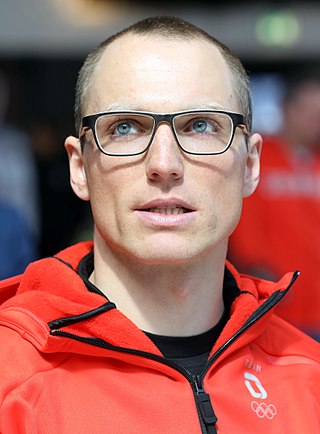
Erik Lesser is a German former biathlete. In 2010, he ran his first single World Cup Race. At the 2014 Winter Olympics in Sochi, he won a silver medal at Men's individual. At the Biathlon World Championships 2013 he won a bronze medal with the German team in Men's relay.
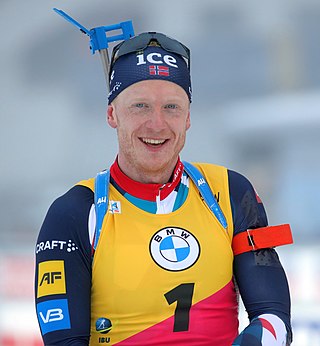
Johannes Thingnes Bø is a Norwegian biathlete. He is the younger brother of biathlete Tarjei Bø. Thingnes Bø has won the Biathlon World Cup in 2018/19, 2019/20, 2020/21, 2022/23 and 2023/24. Thingnes Bø is the second most successful male biathlete of all time in the World Cup with 85 individual World Cup victories, including victories at the Winter Olympic Games.

Stina Nilsson is a Swedish former biathlete and former cross-country skier. She is a five-time Olympic medalist and the 2018 Olympic champion in the individual sprint. In March 2020 she announced that she would switch to competing in biathlon. In April 2024, she announced her return to cross-country skiing, this time as a long-distance racer.
The Women's 10 kilometre pursuit biathlon competition at the 2002 Winter Olympics was held on 16 February, at Soldier Hollow. Competitors raced over four 2.5 kilometre loops and one 2.75 kilometre loop of the skiing course, shooting four times, twice prone and twice standing. Each miss was penalized by requiring the competitor to race over a 150-metre penalty loop.

Slovenia competed at the 2014 Winter Olympics in Sochi, Russia, from 7 to 23 February 2014. Sixty-six competitors were chosen to participate, in eight sports. For the first time since the country's independence, the Slovenia men's national ice hockey team qualified for the Olympic tournament.

Competitive cross-country skiing encompasses a variety of race formats and course lengths. Rules of cross-country skiing are sanctioned by the International Ski Federation and by various national organizations. International competitions include the FIS Nordic World Ski Championships, the FIS Cross-Country World Cup, and at the Winter Olympic Games. Such races occur over homologated, groomed courses designed to support classic (in-track) and freestyle events, where the skiers may employ skate skiing. It also encompasses cross-country ski marathon events, sanctioned by the Worldloppet Ski Federation, and cross-country ski orienteering events, sanctioned by the International Orienteering Federation. Related forms of competition are biathlon, where competitors race on cross-country skis and stop to shoot at targets with rifles, and paralympic cross-country skiing that allows athletes with disabilities to compete at cross-country skiing with adaptive equipment.
This is a chronological summary of the major events of the 2018 Winter Olympics in Pyeongchang County, South Korea. Two events, the curling mixed doubles tournament and the men's normal hill ski jumping competition, held their preliminary rounds on 8 February. The opening ceremony took place one day later on 9 February. The last day of competition and the closing ceremony was on 25 February.
The men's 4 × 10 kilometre relay competition in cross-country skiing at the 2022 Winter Olympics was held on 13 February, at the Kuyangshu Nordic Center and Biathlon Center in Zhangjiakou. Aleksey Chervotkin, Alexander Bolshunov, Denis Spitsov, and Sergey Ustiugov, representing the Russian Olympic Committee, won the event. It was the first gold for Russian athletes in the relay since 1980, when the Soviet Union won. Norway won the silver medal, and France bronze.
This is a chronological summary of the major events of the 2022 Winter Olympics in Beijing and venues near neighboring towns of Yanqing and Chongli in the People's Republic of China. Competition began on 2 February with the first matches in the group stages of the curling events. The opening ceremony was held two days later on 4 February. The last day of competition and the closing ceremony were on 20 February.